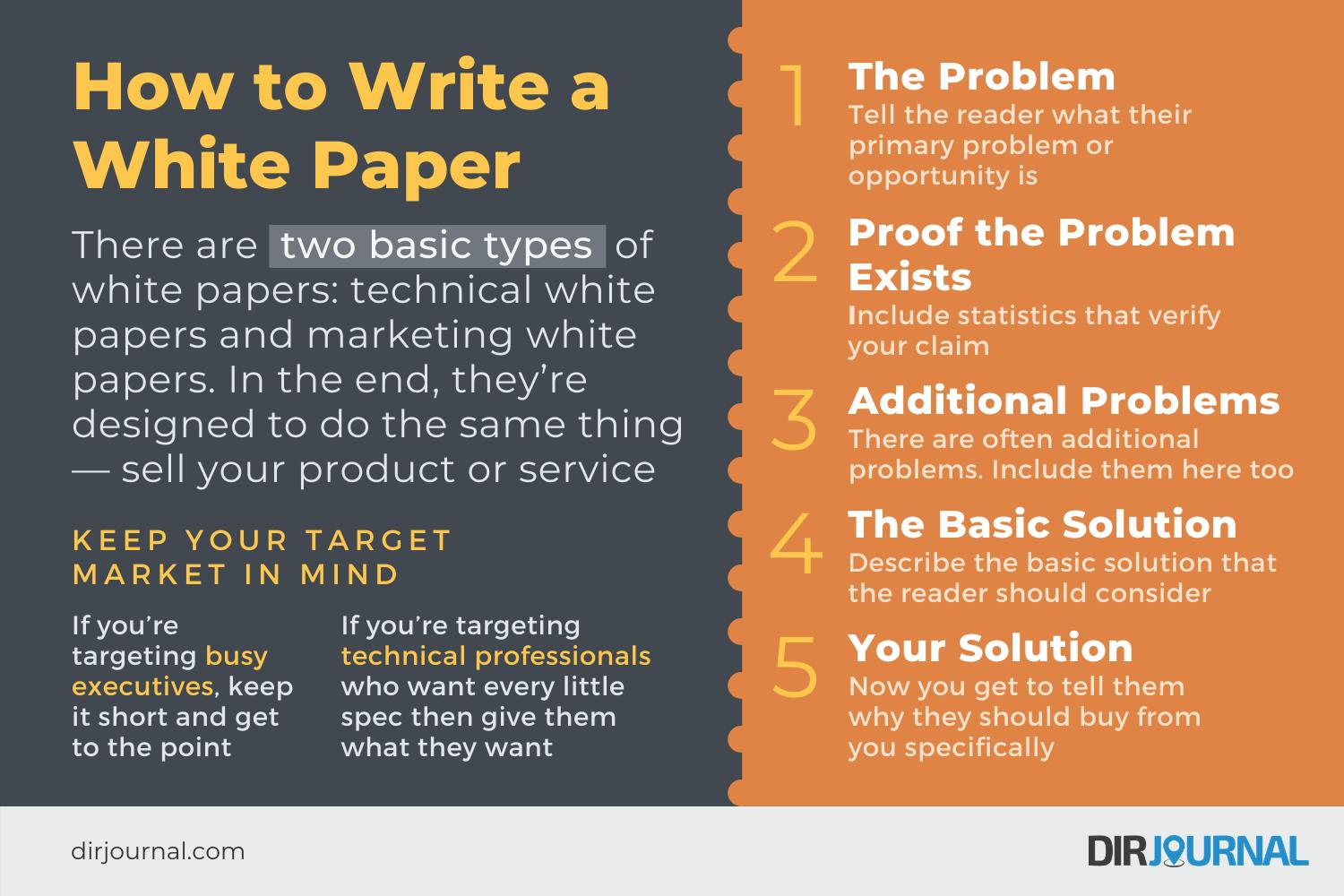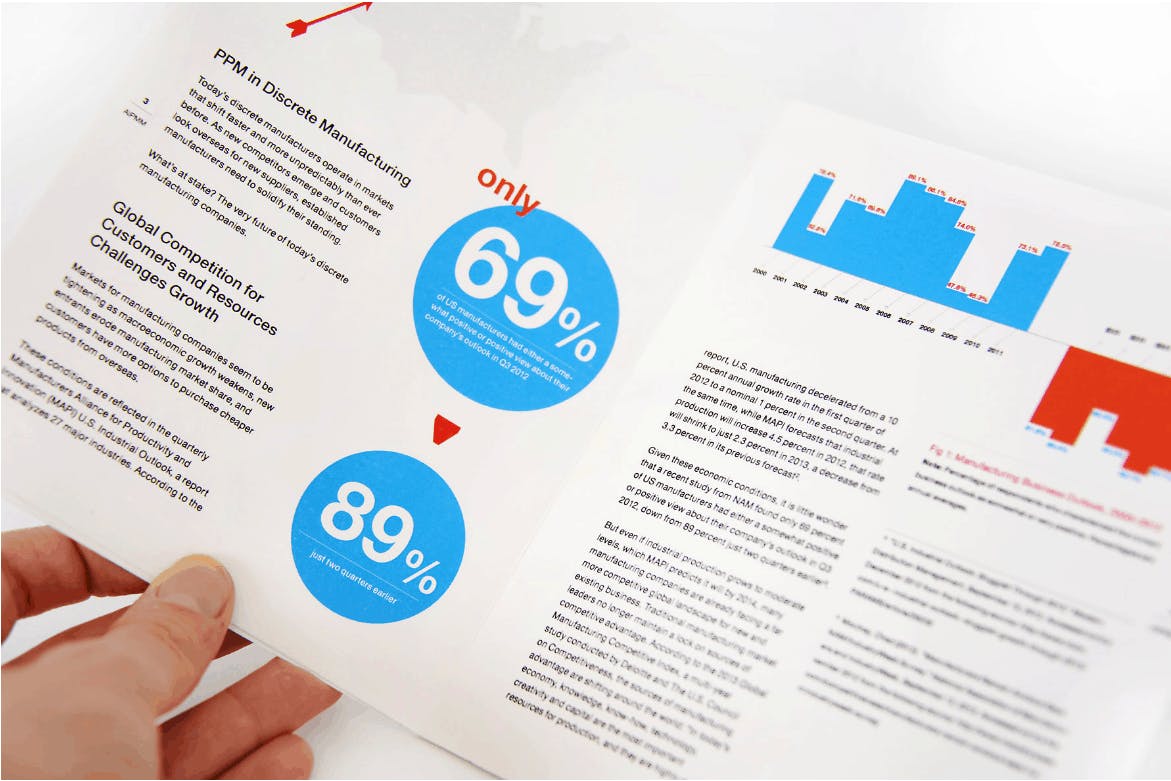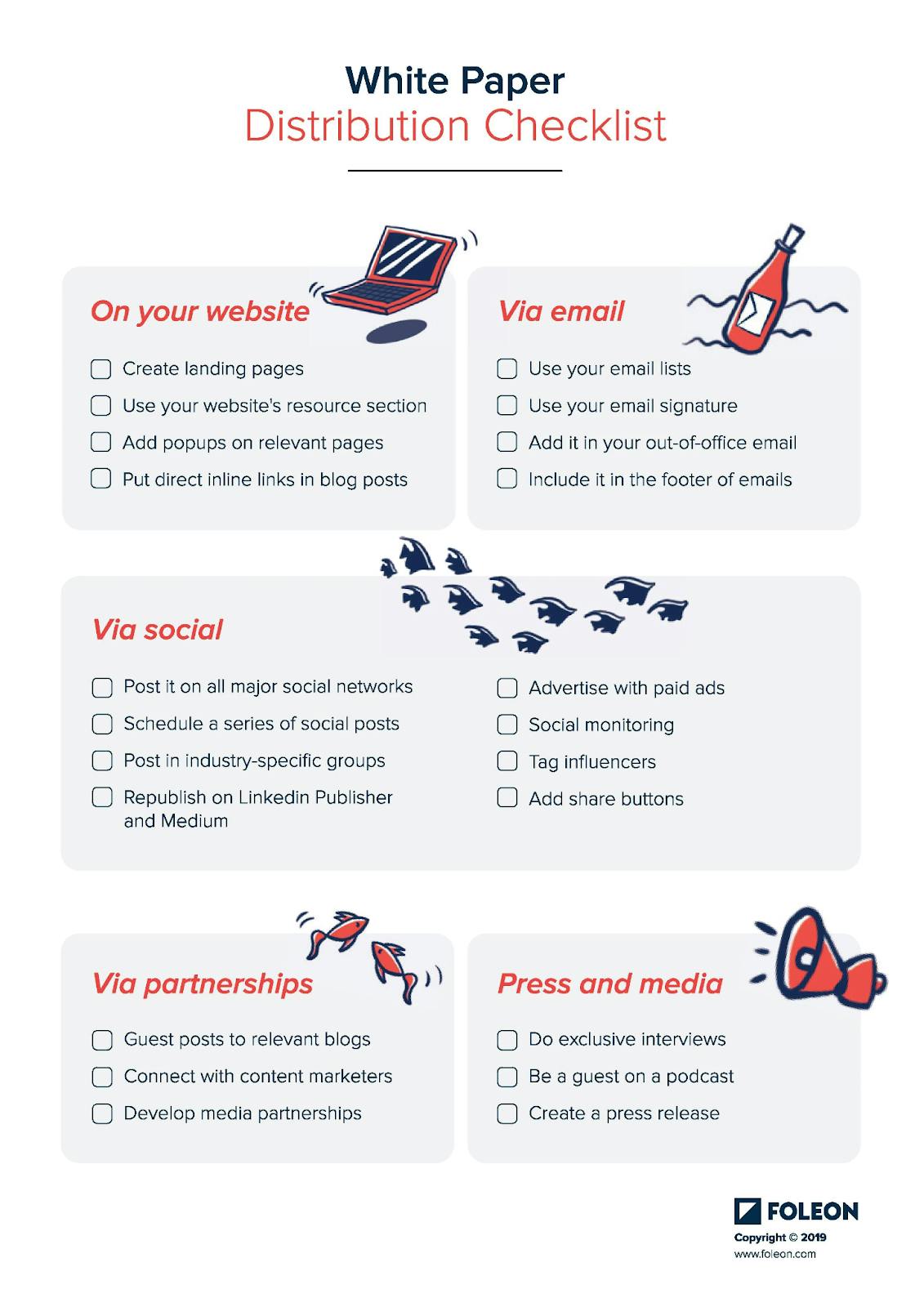What is a white paper and how to write it with examples
Dec 9th, 2022

Contents
What is a white paper?
How to write a white paper
White paper examples
Should you gate your white paper?
If your business objectives are to promote your product or service, generate leads, establish thought leadership and encourage your potential customers to purchase the product, you can create a white paper. Marketing specialists write white papers to educate their audience about a specific topic or describe and promote some methodology. These in-depth reports can highlight the features of your product or service and help your customers find solutions to their problems.
However, to create an excellent white paper, you must have clear goals, relevant topics, and new information to share. In this article, we will take a closer look at white papers, consider their unique features and describe the differences between white papers, case studies, ebooks, and blog articles. We will also discuss the process of writing a white paper and provide several examples of this content type.
What is a white paper?
A white paper is a report or guide that gives a thorough overview of a topic while promoting a company’s goods or services and enticing readers to use them. A white paper presents a potential solution to customer problems, describes the product’s features and justifies why a product or service is the perfect option for the given issue. In addition, this marketing document contains studies, surveys, and other statistics supporting the provided information. The audiences for white papers include prospective clients, investors, journalists, analysts, and stakeholders.
A white paper is a form of content marketing or inbound marketing. It is a piece of content that allows for generating traffic and increasing the company’s visibility in search engines. A document is typically written in an academic style and contains at least 2,500 words. White papers are created for two primary purposes: educating potential customers about the topic while positioning a company as an authority and encouraging consumers to purchase the offered product or service. In addition, whitepapers are often presented as gated content, so consumers should fill out a form with their contact information to download material.

There are three categories of white papers: backgrounder, numbered list, and problem/solution. The backgrounder describes the technical or business advantages of the product. This white paper is most effective for supporting a technical evaluation or product launch. A numbered list or listicle provides a series of recommendations, questions, or points regarding a specific business issue. These white papers are intended to draw attention with provocative ideas, nurture leads, or cast doubt on competitors. Finally, problem/solution papers present a new solution to a problem, generate leads, and inform and persuade stakeholders.
Although a white paper is a sales document, it differs from a product pitch or presentation. A white paper is useful and informative and provides only facts without opinions. It aims to build trust with the audience and increase brand awareness. Sales pitch, in contrast, is written in a more aggressive tone and focuses mainly on the product’s benefits. While the goal of a product pitch is to convince the audience to buy your product straight away, a white paper uses facts and logical arguments to inform the readers about your solution and explain why it is the best choice.
Now we will compare a white paper with a research paper, case study, ebook, and blog article and look at their distinctive features.
White paper vs research paper
Research papers are scholarly publications in journals that feature the findings of original studies or criticism of other researchers’ works. A research paper aims to contribute to the body of knowledge in a particular field. Research papers are usually written to support or refute a theory and present recent findings. These publications are frequently examined by academics who are specialists in various branches of science and technology. It often takes a long time to publish a research paper as it requires peer reviews.
White papers typically address complex issues through technical discussions. These documents are used in product marketing to highlight a specific viewpoint or product and influence consumer purchasing decisions. Although a white paper is presented scientifically and logically, it is intended to impact customers in a way that benefits the business. While research papers are created by engineers, scholars, and doctors, the authors of white papers are technical writers, internal company personnel, and subject matter experts.
Research papers are mostly published for informational and educational purposes. Hence academics like students, professors, researchers, and scientists make up the majority of their readers. On the other hand, white papers’ audience is prospective customers, so they might increase sales of a specific brand, product, or service.
White paper vs case study
A case study is a record of research conducted to examine a specific problem or circumstance during a given period. For example, in a business case study, an author may explore the organization’s strategy, analyze how consumers use a product, or describe the state of the market. The goal of a case study is to educate readers, inform the audience about a problem and provide recommendations. In essence, both a white paper and a case study describe the advantages of a product or service while demonstrating how a particular method has turned out to be an efficient remedy for the problem.
However, there are some significant differences between white papers and case studies. Case studies are more concise, while white papers are longer, involve technical research, and provide detailed suggestions on resolving the issue. The former demonstrates the effectiveness of a solution and provides real-life examples. Case studies also place greater emphasis on observation and examination. White papers, in contrast, focus primarily on theoretical information and highlight crucial characteristics of a product or methodology.
White paper vs ebook
An ebook or electronic book is a digital publication that contains text, photos, and interactive elements like links and videos. Ebook provides recommendations, answers, or strategies for an industry or niche. White papers and ebooks share certain similarities. For instance, both marketing assets can be used to establish a company as a thought leader, build credibility and generate leads. Besides, ebooks and white papers have a longer lifespan than other content marketing formats. You can use the documents for a few years and repurpose them in different ways: turn them into a series of blog articles, create an infographic, or include the publications in newsletters.

The primary difference between an ebook and a white paper is the audience. An ebook is a comprehensive guide on a specific topic targeted predominantly at a general audience. A white paper is an academic report that targets a niche audience of specialists and presents new research. The other difference is the objective. The purpose of a white paper is to educate the audience and highlight the brand’s value proposition. Ebooks are also more informative and comprehensive. These assets serve as guides for broader topics. Finally, ebooks are longer and have a formal structure, while white papers often include the following components: a problem, methodology, guidance, and resolution.
White paper vs blog article
A blog article is a piece of content posted on a blog which is a website or a section of the site. Blog article often includes text, images, and videos. A blog article aims to briefly overview the subject, generate leads, and market products and services. On the other hand, a white paper’s primary goal is to give a complete idea about the topic. Although blog articles can present facts, these content pieces are usually not data-focused and are much shorter than white papers.
The other difference between white papers and blog articles is the tone. White papers require an official and professional style, while blog articles can be written in a more informal manner. White papers require more research and provide a thorough analysis of a product or service. Therefore, completing a comprehensive white paper can take weeks to months. A blog article is more straightforward, so writing one can take a few hours to several days. White papers are designed to draw qualified leads and prospects, whereas blog articles are less technical and can reach a wider audience.
Once you are familiar with different content formats and their differences from a white paper, let us discuss the process of writing a white paper from ideation to publication and distribution.
How to write a white paper
An excellent white paper needs to be thoroughly researched and present new information that readers cannot find through an internet search. Moreover, a white paper should be engaging and maintain the audience’s interest. Now we will describe how to write an excellent white paper in greater detail below.

Step 1. Define your audience
Defining your audience is one of the most crucial steps in creating a well-researched white paper. First, you need to consider what kinds of readers you want to attract. For example, you can use specific jargon if your audience is professionals in the industry. Furthermore, the statistics and provided information should be relevant to your target audience. Knowing your readers’ interests also narrows the scope of research you should conduct.
When determining your audience, consider the following characteristics: educational background, job title, and professional needs. Think about which platforms and search queries your readers use to find information. Conduct in-depth research to understand why your audience is interested in this topic, how much knowledge readers already have about the subject, and how your white paper can help them. In addition, interview your clients and check the comments from your audience to learn about their main problems and goals.
Step 2. Choose a relevant topic and research it
Choosing an impactful topic for a white paper is a crucial component of its success. When defining the topic, make sure you are qualified to write about it and that your audience is interested in the problem. Beyond that, the topic should fill the content gap, which means that there should not be much information online on the subject. Your topic may concern a product or an innovative business idea. A white paper can describe a particular aspect of your business or your team’s accomplishments.
Ask your audience about their expectations, check other reports and studies to identify content gaps, and interview other industry experts to develop an idea for a white paper. Then find credible sources and collect expert opinions and statistics. Finally, fact-check the information to verify its accuracy.
Step 3. Make an outline
The following step is to create an outline that determines your target audience, defines the structure, and organizes the study. When creating a plan for your paper, think about how to summarize your findings in a way that addresses the issues of your readers. Make a list of concepts and crucial matters you should address within each section.
A white paper typically consists of the following elements: title, abstract or summary, introduction, section subheadings, sources, and conclusion. First, you need to describe a problem or situation. Secondly, you should provide a methodology and instructions. Finally, you need to explain possible solutions to the problem.
Step 4. Provide valuable information
It is critical to remember that a white paper’s goal is to provide helpful information to an audience even if they do not become your clients. Make sure each paragraph brings value and makes readers feel they have learned something new. A white paper should demonstrate your expertise in a particular field as a business or brand.
Use proven facts and statistics to make a white paper more trustworthy. Thus, your audience will perceive the company as a reliable source of information. In addition, building a reputation as an expert will increase your chances of achieving success, as customers are willing to buy from businesses they trust.
Now you need to format the content of your document. Use bullet points and subheadings to divide the text into sections and make it easier to read. You can also add charts and graphs to capture readers’ attention and highlight the concepts you want people to remember. You can decide how to format the paper by looking up various examples and templates.
Step 5. Proofread and edit
When writing a white paper, maintain a formal tone. Use language appropriate for the audience you are targeting. Avoid using informal language, slang, and expressions that are not suitable for academic writing. Although keyword optimization is crucial, remember to write for your readers instead of search engines. Google is constantly improving its capacity to recognize and match relevant information with search queries.
Do not worry about creating a perfect white paper on the first draft. It may require several revisions to finalize a report. To ensure your white paper is exciting and understandable, hire professional proofreaders or try editing a document yourself.
Step 6. Distribute and promote your paper
Creating the document is only the first step. You also need to ensure it reaches the desired audience. For instance, you can send a press release to advertise the publication of a new paper or share it through LinkedIn or Twitter. The other way to promote the publication of the white paper is to send it to your prospects after a demo call to provide more information. A smart strategy to distribute your white papers is to embed or link them to relevant landing pages, guest blogs, and newsletters.
White paper syndication or publishing the same document on independent websites enables companies to target a niche market, generate leads, and increase the reach of a white paper. Besides, a white paper distribution through content syndication is very effective as it allows for repurposing content and promoting it on various platforms.

Next, we will look at white paper examples from different companies in various industries to provide you with an understanding of how to create a white paper.
White paper examples
In this section, you can find three white paper examples to collect ideas for creating your own.
Cisco’s white paper
Cisco is a company that develops and provides network equipment, data security services, and telecommunications gear. The company created a white paper called “Networking and your competitive edge”, where Cisco explained the importance of having a secure and reliable network edge. The advantages of this white paper are a large number of infographics, quotes, statistics, and balanced use of text and visuals. Plus, the document allows people to understand a complex topic with the help of the simple and engaging language of the presentation.
Google’s white paper
The white paper called “Cloud security and compliance” by Google is a 28-page tutorial demonstrating the effectiveness of Google cloud products and services in protecting the data of any workspace. The white paper has all the components of a well-written, readable document, including subtle color fonts, pictures, and plain language. What is more, Google repurposed the white paper and created the infographic for people who do not have time to read the entire document.
Uber’s white paper
In the paper called “Fast-forwarding to a future of on-demand urban air transportation”, Uber promotes the idea of air transportation and establishes the company as a key figure in its creation. The company describes its VTOL aircraft, explains the need for it in urban areas, and lists the obstacles that should be overcome. Uber also mentions reviewers from NASA, MIT, and other prestigious air transportation organizations to increase the report's credibility. As a result, the company establishes itself as a thought leader by describing future trends and innovations in the industry.
You can use the above-mentioned practices tested by reputable companies to create a white paper that will educate your audience, generate leads and increase sales.
Should you gate your white paper?
Companies can use gated content like white papers to grow contact lists for marketing and sales teams. Gated content is any publication that readers can access by providing personal details like name and email. A company creates a landing page that contains a description of available content and a form where users can enter contact information and gain access to the materials.
There is no definitive answer to whether you should gate a white paper. On the one hand, gating your content is a great way to generate leads. Moreover, a successful buyer's journey often starts with gated content as the very first step. Most people who provide contact information are interested in your company because of your regular distribution of useful content.
On the other hand, gating your white paper reduces the number of people who will read the document because not everyone wants to share their personal details. Therefore, if your white paper is not gated, it will attract a larger audience and can improve your search rankings. However, gating a white paper will stop search engines from indexing a publication.
Creating a perfect white paper may require a lot of time and effort. Nevertheless, this results in a valuable document that promotes your company’s expertise and fosters general education and development in your industry. A perfect white paper contributes to the company’s growth.
